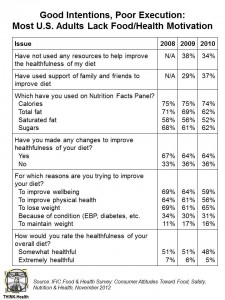 Notwithstanding the fact that most phones on U.S. streets are “smart” ones, most adults surf the net for health information, and most people try to change a health habit each year, Americans haven’t adopted healthier long-term relationships with food.
Notwithstanding the fact that most phones on U.S. streets are “smart” ones, most adults surf the net for health information, and most people try to change a health habit each year, Americans haven’t adopted healthier long-term relationships with food.
The International Food Information Council has conducted the Food & Health Survey: Consumer Attitudes Toward Food, Safety, Nutrition & Health poll since 2006, thus enabling us to track peoples’ attitudes and behaviors over the past several years. The latest polling results appear in Is it Time to Rethink Nutrition Communications? A 5-Year Retrospective of Americans’ Attitude toward Food, Nutrition, and Health online in the Journal of the Academy of Nutrition and Dietetics.
Looking at the data, which I selected from a larger database for purposes of summarizing a few key trends, there’s a major disconnect among U.S. consumers who rate their health as good to excellent, although we know the rates of overweight and obesity are epidemic. Thus, people don’t connect the dots between their weight and collectively high BMI vis-a-vis their personal health. Researchers note a decline in concerns about weight, saying this suggests “a movement toward complacency with weight status.”
While 8 in 10 Americans say they’re trying to lose or maintain their weight, the ongoing march toward overweight and obesity continues. The top three barriers to losing or maintaining weight are lack of will power, lack of time, and lack of quick results.
Further confounding people trying to lose weight is confusion with calories. Health consumers simply don’t know what their personal calorie intake should be based on their current weight, goals, and energy consumption in a day (i.e., activity/exercise, basal metabolic rate, etc.).
In the article, Betsy Hornick, a registered dietitian, and the team who analyzed the IFIC survey research write that, “Helping Americans achieve diet and physical activity goals means more than just communicating what to do. Communications must reach consumers where they eat, work, and play, and include strategies that both inspire and guide them on how to make healthful behavior changes.”
 Health Populi’s Hot Points: As we approach January 1, 2013, when the new year finds folks re-enrolling in gyms throughout the nation, joining Weight Watchers and Nutrisystem to jump-start weight loss resolutions, and watching sales of Nike, New Balance, and ASICS shoes spike, this survey is a sobering reality check on what’s not working.
Health Populi’s Hot Points: As we approach January 1, 2013, when the new year finds folks re-enrolling in gyms throughout the nation, joining Weight Watchers and Nutrisystem to jump-start weight loss resolutions, and watching sales of Nike, New Balance, and ASICS shoes spike, this survey is a sobering reality check on what’s not working.
One fact that stands out is the trend that, while about 3 in 4 consumers have focused on calorie information on the Nutrition Facts Panel since 2006, peoples’ attention to total fat, saturated fat, and sugars has decline “significantly,” according to the authors.
The authors’ focus is on re-imagining nutrition and health messages, and I believe that’s key to helping better inform and arm people with facts and clarity around food, calories, and health.
But let’s not put all the pressure on nutritionists and primary care health providers. When it comes to food and health, it takes a village — as my guru Dr. Regina Benjamin, U.S. Surgeon General reminds us, health is where we live, work, play and pray.
The IFIC survey finds that taste and price are the top two factors that influence purchasing decisions of food and beverages. Healthfulness ranks third, then convenience. We’re into instant gratification — that’s the taste driver — and value, which is the price driver.
Dr. Benjamin’s reminder is key for food: that virtually every consumer carries a mobile phone, and an increasingly smart one, means that everyone has access on-the-go to nutrition information, and also games and social networks — all of which can bolster health messages, motivation and ongoing support. Fooducate, Hemi Weingarten’s brilliant mobile app, helps us make sound point-of-purchase decisions in the grocery store — and not only for us, but for our kids in the sugary cereal aisle which presents a marvelous teachable moment when it comes to children’s health at the point of decision making.
“Stopping to really listen to consumers regarding their current behaviors and concerns is what is needed to equip them with practical, relevant, and actionable strategies for implementing and sustaining healthful changes,” the authors assert. “Otherwise, consumers will continue to see dietary changes as a ‘do-it-yourself’ project to be completed some other day — with or without the right ‘tools.'”
I’ve argued here on Health Populi, in my writings and in public speeches, about this emerging HealthcareDIY era. We are already ‘here’ when it comes to people project-managing health in their own personal health ecosystems. To get HealthcareDIY right involves getting the right information to the right people at the right time, and surrounding them with delightful, enchanting, and entertaining tools that support each of us in our journey toward health. Hornick and her colleagues remind us we’ve a long, long way to go.




 Interviewed live on BNN Bloomberg (Canada) on the market for GLP-1 drugs for weight loss and their impact on both the health care system and consumer goods and services -- notably, food, nutrition, retail health, gyms, and other sectors.
Interviewed live on BNN Bloomberg (Canada) on the market for GLP-1 drugs for weight loss and their impact on both the health care system and consumer goods and services -- notably, food, nutrition, retail health, gyms, and other sectors. Thank you, Feedspot, for
Thank you, Feedspot, for  As you may know, I have been splitting work- and living-time between the U.S. and the E.U., most recently living in and working from Brussels. In the month of September 2024, I'll be splitting time between London and other parts of the U.K., and Italy where I'll be working with clients on consumer health, self-care and home care focused on food-as-medicine, digital health, business and scenario planning for the future...
As you may know, I have been splitting work- and living-time between the U.S. and the E.U., most recently living in and working from Brussels. In the month of September 2024, I'll be splitting time between London and other parts of the U.K., and Italy where I'll be working with clients on consumer health, self-care and home care focused on food-as-medicine, digital health, business and scenario planning for the future...